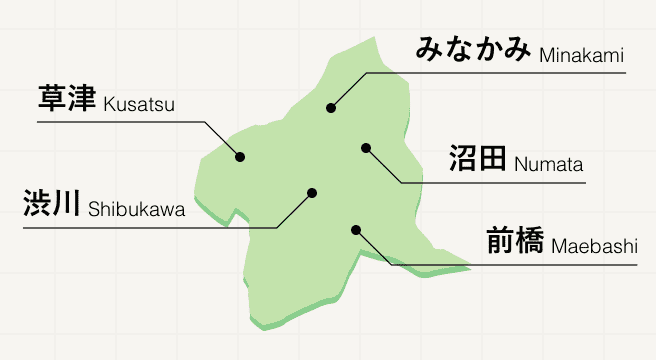Cultural Property Spots in Gunma Area
Area
-
-
Gunma
-
-
Gunma

Category


-
- Rinkokaku
-
4.546 Reviews
- Travel / Tourism
- Gunma Pref. Maebashishi Otemachi 3-15
- A modern Japanese-style wooden building located in Ote-machi, Maebashi City. The main building and tea house are prefecturally-designated Important Cultural Properties, while the annex is designated an Important Cultural Property by the city of Maebashi. The main building was constructed as a reception hall in 1884, while the drawing room-style annex was built in 1910 for hosting noble visitors. The tea house, built in 1884, thoroughly incorporates Japanese “wabi” design principles and is constructed in the thatched hut style. In addition to being used for events, the Rinkokaku’s facilities may be used for taking wedding photos and other photography purposes with an advance application. There is a store on the first floor of the annex selling local Maebashi souvenirs and other goods.
-
明治17年にできた数寄屋造りの2階建の迎賓館(本館)、明治34年には150畳の大広間を含む書院風の貴賓館(別館)が増築されています。 国の重要文化財ですが、現在は、屋内も含めて無料で見学ができますし、部屋を借りることも可能です。 ちなみに、日本庭園の池のほとりの和室も貸し出し可能です。 さらにちなみに、日本庭園も無料で入れることもあってか、結婚の記念撮影をしているカップルが何組かいました。
-
- Old Bell Clock Tower
- Travel / Tourism
- Gunma Pref. Isesakishi Kuruwachou 28-23
- This Old Bell Clock Tower in the Isezaki Domain lord’s residence is the oldest reinforced concrete structure in Gunma. Completed in 1916 during the Taisho period thanks to the donation of Keisuke Kobayashi who runs a chemist in Yokohama. It told the time to the town until 1937 when the metal in the clock and bell was used for the war efforts. The clock was restored after the war to its Taisho period state for the municipal government’s 50th anniversary. You can get a great feeling for the romanticism of the Taisho period with the red brick walls, renaissance windows and domed roof.
-
- Former Soga Textile Mill
- Travel / Tourism
- Gunma Pref. Kiryushi Honchou 1-7-15
- Located a 20 minute walk north of JR Kiryu Station. Soga Sukematsu built his fortune in the Meiji period, moving from working as a live-in apprentice for a raw silk thread dealer to becoming a tycoon in the silk thread market, and one of the things he purchased with this fortune was the land here. In 1922, he had this mill built to celebrate the wedding of his son, Kiichiro. Built with Oya tuff stone and consisting of five conjoined buildings with a saw-tooth roof, the mill produced silk goods up until 1970. Today it is preserved as a National Tangible Cultural Property; only the exterior is available for viewing by visitors. The structure still retains the atmosphere of a bygone era from the city of Kiryu’s past.
-
- Former Hirata Family Residence and Shop
- Travel / Tourism
- Gunma Pref. Kiryushi Honchou 1-6-28
- A 15 minute walk from JR Kiryu Station. The area where this building is located was selected as an Important Preservation Districts for Groups of Traditional Buildings in 2012. This historic former residence and shop stands on the east side of the central road passing through. The first owner of the shop, Hirata Uhachi, set up his own general store in 1851; thereafter, the store carried dyes and raw silk thread, but the difficulties of acquiring stock during the war forced it to close. The structure is a rare example of Meiji-period townhouse architecture and the primary building and adjoining storehouse were registered as Tangible Cultural Properties in 2006.
Gunma Areas

Gunma prefecture is synonymous with onsen. Natural hot spring water sources throughout the prefecture have given rise to a series of small onsen towns, each set among luscious mountains. At Kusatsu, Ikaho, and Minakami, traditional indoor and outdoor bathing experiences are served hand in hand with irresistible onsen-themed food, including steam-cooked eggs and custard pudding.
Best of Gunma
Search by Region
-
- Hokkaido / Tohoku
- Hokkaido
- Aomori
- Iwate
- Miyagi
- Akita
- Yamagata
- Fukushima
-
- Kanto
- Ibaraki
- Tochigi
- Gunma
- Saitama
- Chiba
- Tokyo
- Kanagawa
-
- Koshinetsu / Hokuriku
- Niigata
- Toyama
- Ishikawa
- Fukui
- Yamanashi
- Nagano
-
- Tokai
- Gifu
- Shizuoka
- Aichi
- Mie
-
- Kinki
- Shiga
- Kyoto
- Osaka
- Hyogo
- Nara
- Wakayama
-
- Chugoku
- Tottori
- Shimane
- Okayama
- Hiroshima
- Yamaguchi
-
- Shikoku
- Tokushima
- Kagawa
- Ehime
- Kochi
-
- Kyushu / Okinawa
- Fukuoka
- Saga
- Nagasaki
- Kumamoto
- Oita
- Miyazaki
- Kagoshima
- Okinawa
















